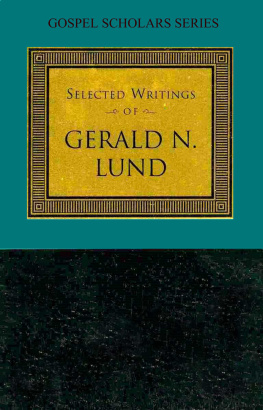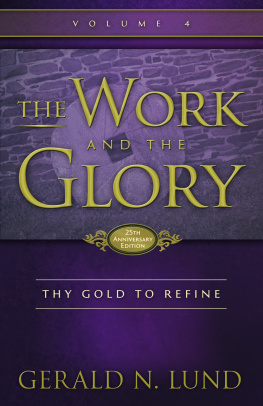Selected Writings of Gerald N. Lund
Gerald N. Lund
2012 Gerald N. Lund.
All rights reserved. No part of this book may be reproduced in any form or by any means without permission in writing from the publisher, Deseret Book Company, P.O. Box 30178, Salt Lake City Utah 30178. This work is not an official publication of The Church of Jesus Christ of Latter-day Saints. The views expressed herein are the responsibility of the author and do not necessarily represent the position of the Church or of Deseret Book. Deseret Book is a registered trademark of Deseret Book Company.
Publisher's Preface
In recent decades, a number of exceptional Latter-day Saint scholars have expanded our understanding of many gospel subjects. In many cases, however, much of what they have written (or given as speeches) has been published for relatively small audiences, or it was published so long ago as to be unavailable or inaccessible to most readers; in some cases an article or paper has never been published at all. Now Deseret Book is pleased to bring together some of "the best of the best" in the Gospel Scholars Series.
Insights from the Scriptures
Chapter 1
Understanding Scriptural Symbols
What are we to do with all of the symbolic language in the Biblethe imagery, figurative expressions, parables, allegories, types, shadows, similes, and hyperbole? Sometimes this imagery is clear and powerful, but often it seems baffling and strange.
Approximately 27 percent of the 1,184 pages of the Old Testament is made up of prophetic writings, or what the people at the time of Christ called simply "the prophets." (See, for example, Luke 24:27, 44.) At almost any point in those writings, we are immediately confronted by symbolic language.
Sidney B. Sperry noted some years ago that this penchant for figurative language is partially due to the fact that the Bible is the product of Oriental or Eastern peoplesand Eastern peoples are much more prone to use imagery than are the Occidentals or Western cultures:
"We ofttimes read our Bible as though its peoples were English or American and interpret their sayings in terms of our own background and psychology. But the Bible is actually an Oriental book. It was written centuries ago by Oriental people and primarily for Oriental people....
"It may be of interest to contrast the speech of modern and ancient Palestinians with our own. In thought and speech the Oriental is an artist; the Occidental, on the other hand, may be thought of as an architect. When speaking, the Oriental paints a scene whose total effect is true, but the details may be inaccurate, the Occidental tends to draw diagrams accurate in detail."
While this difference provides some interesting challenges for the modern reader in our Western civilization, those challenges are not insurmountable, and when they are met, the returns can be productive and satisfying.
Since a thorough explanation of the use of symbolic imagery in the Old Testament, or even in "the prophets," would require a work far beyond the scope of this article, we shall only give a general introduction to the subject. This introduction, however, should serve to help decipher imagery wherever it is found in the scriptures.
The Prophet Joseph Smith said: "I make this broad declaration, that whenever God gives a vision of an image, or beast, or figure of any kind, He always holds Himself responsible to give a revelation or interpretation of the meaning thereof, otherwise we are not responsible or accountable for our belief in it. Don't be afraid of being damned for not knowing the meaning of a vision or figure, if God has not given a revelation or interpretation of the subject."
There are occasional uses of figurative imagery, such as Ezekiel's "wheels" (see Ezek. 1:15-21), for which the Lord has not yet given us the interpretation. But for the most part, we do have the keys for understanding the symbolic imagery used by the Lord and his prophets.
Six guidelines can aid us as we deal with figurative language in the scriptures:
1. Do the scriptures give the interpretation of the symbol? Often the Lord reveals the keys to the imagery right in the scriptures. A classic example is the interpretation of Nebuchadnezzar's dream (see Dan. 2:19, 31-45). Another example is Isaiah. After using the imagery of a neglected and run-down vineyard, the Lord says, "For the vineyard of the Lord of hosts is the house of Israel, and the men of Judah his pleasant plant" (Isa. 5:7). There is no need for speculation or debate. The answer is clear.
In these two cases, the scriptural interpretations were given in context. More frequently, the interpretation is found elsewhere in scripturesometimes even in a completely different work of scripture. For example, Daniel's use of the phrase "Ancient of days" (see Dan. 7:9, 22) refers to Adam, but we discover that through the Doctrine and Covenants (see, for example, D&C 27:11; 107:54).
2. Do the writings of modern prophets help us interpret the symbolic imagery? Sometimes the key to understanding a symbol may not be found directly in the scriptures, but prophets of the Restoration have helped clarify the meaning. A good example of this is found in one of Joseph Smith's sermons. While the Lord reveals through Daniel that the beasts he saw in Dan. 7 and 8 represent various kingdoms (see Dan. 8:20-21), the Prophet Joseph Smith helps us better understand why this imagery is used.
"You there see that the beasts are spoken of to represent the kingdoms of the world, the inhabitants whereof were beastlyand abominable characters; they were murderers, corrupt, carnivorous, and brutal in their depositions."
3. Use the study aids in the new editions of the scriptures. An invaluable source of help for English readers is found in the study aids of the LDS edition of the King James Version. Chapter headings, footnotes, cross-references, the Topical Guide, and the Bible Dictionary were prepared under the direction of the Scriptures Publication Committee (which consisted of several members of the Quorum of the Twelve). These provide consistent and important help in interpreting symbolic imagery.
For example, in the headings to Isa. 13 and 14 we learn that Babylon is used as a type, or symbol, of the world. In footnote b to Jer. 23:5, we learn that "Branch" is a symbolic name for Jesus Christ. And note how a very puzzling reference to "palmerworms" and "cankerworms" is cleared up by footnote a to Joel 1:4.
4. Let the nature of the symbol teach you. While the Hebrews loved imagery and used it heavily, they did not choose their symbolism arbitrarily. They drew their imagery from the objects and events of everyday life and made spiritual parallels. This is a very important point, for often we can let the symbol itself teach us about its significance.
Again let us draw on some examples to illustrate. Jeremiah wrote the book of Lamentations when Judah fell captive to Babylon. In the closing chapter he laments, "The crown is fallen from our head: woe unto us, that we have sinned!" (Lam. 5:16). The imagery of the crown is clear. The crown is a symbol of the power to rule; therefore, Jeremiah's imagery tells us that Judah lost the governing power she once held. As another example, the Lord warns the northern kingdom of Israel that because of their wickedness he will "meet them as a bear that is bereaved of her whelps" (Hosea 13:8). The ferocity and terrifying destructive power of a mother bear separated from her cubs is clear and has great impact.















